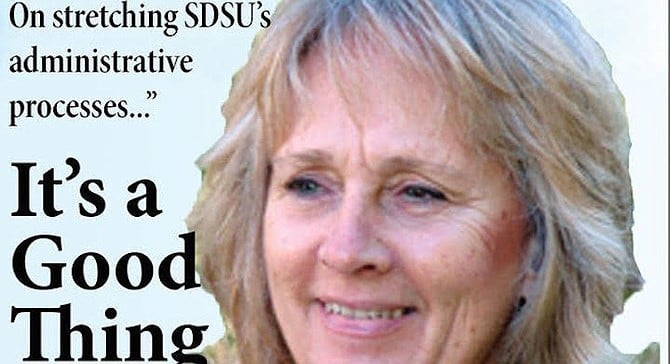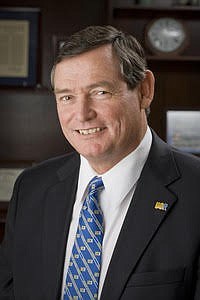 Facebook
Facebook
 X
X
 Instagram
Instagram
 TikTok
TikTok
 Youtube
Youtube

Just as the San Diego city council was disposing of the controversial SoccerCity development in Mission Valley on Monday, June 20, the California State University system, proprietor of San Diego State, issued a call for high-powered developer talent.

The so-called request for qualifications, posted online, is dated three days hence, June 23, likely betraying the anxiousness of state university officials to catch up to the La Jolla hedge fund mavens whose initiative drive still has a shot at privatizing Qualcomm Stadium come election time in November 2018.
“The California State University is a leader in high-quality, accessible, student-focused higher education,” says the document issued by the office of university chancellor Timothy White.
“To assist the CSU in meeting the mission of its universities, the acquisition of property or the development of public-private partnership projects may take place which require real estate financial advisory services.”
The university system, according to the document, “intends to select a limited number of the most highly qualified firms capable of providing a high level of real estate financial advisory services involving complex projects” as early as this October.
“It is intended to establish Master Enabling Agreements with such firms, and to provide CSU campuses with the ability to negotiate scope and cost for the development of advisories with such firms.”
Tasks awaiting the experts include “public-private deal structuring, including financial structure, alternative financing options, and assessment of equity participation,” as well as “evaluation of outside funding sources,” and “analysis for public-private partnerships, potentially to include developments on ground leased CSU property, lease-leaseback transactions, and alternative ownership positions.”
Insiders say some high-level advice might have come in handy during the year-long series of secret meetings between SDSU president Elliot Hirshman, mayor Kevin Faulconer, and the SoccerCity developers that blew up last month with the university calling for “a transparent [Request for Proposal] process “to develop a plan that will accomplish the community’s vision for this vital property and serve the San Diego region for decades to come.”
That caused SoccerCity partner Nick Stone to lash out at Hirshman, saying the exiting president was “moving the goal posts” in their negotiations.
Stone subsequently blasted what he claimed was interference in the Hirshman talks by former city manager Jack McGrory, a major player on the board of SDSU’s Campanile Foundation, who Stone charged was affiliated with a competing effort by ex-U-T publisher Doug Manchester to redevelop the Qualcomm site.
“We were perplexed by the university’s sudden disengagement after we reached agreement and even more so by their subsequent refusal of any further discussions,” Stone told the Union-Tribune.
“Now we come to learn that while Jack was leading negotiations for the university, he was simultaneously part of a project team pursuing its own plan for the same site.” Both McGrory and Manchester denied any deal between them was afoot.
How much the state university system is prepared to pay its newly recruited high-dollar real estate talent remains to be seen, though independent observers expect taxpayers to ultimately be on the hook for at least seven or eight figures as the tug-of-war with Stone and company rages on.
Acting SDSU president Sally Roush, who will be getting the same $428,645 annual salary as the exiting Hirshman during her interim reign, is known as a rough-and-tumble campus infighter and hardnosed negotiator from her earlier stint as SDSU’s vice president of business and financial affairs.


Just as the San Diego city council was disposing of the controversial SoccerCity development in Mission Valley on Monday, June 20, the California State University system, proprietor of San Diego State, issued a call for high-powered developer talent.

The so-called request for qualifications, posted online, is dated three days hence, June 23, likely betraying the anxiousness of state university officials to catch up to the La Jolla hedge fund mavens whose initiative drive still has a shot at privatizing Qualcomm Stadium come election time in November 2018.
“The California State University is a leader in high-quality, accessible, student-focused higher education,” says the document issued by the office of university chancellor Timothy White.
“To assist the CSU in meeting the mission of its universities, the acquisition of property or the development of public-private partnership projects may take place which require real estate financial advisory services.”
The university system, according to the document, “intends to select a limited number of the most highly qualified firms capable of providing a high level of real estate financial advisory services involving complex projects” as early as this October.
“It is intended to establish Master Enabling Agreements with such firms, and to provide CSU campuses with the ability to negotiate scope and cost for the development of advisories with such firms.”
Tasks awaiting the experts include “public-private deal structuring, including financial structure, alternative financing options, and assessment of equity participation,” as well as “evaluation of outside funding sources,” and “analysis for public-private partnerships, potentially to include developments on ground leased CSU property, lease-leaseback transactions, and alternative ownership positions.”
Insiders say some high-level advice might have come in handy during the year-long series of secret meetings between SDSU president Elliot Hirshman, mayor Kevin Faulconer, and the SoccerCity developers that blew up last month with the university calling for “a transparent [Request for Proposal] process “to develop a plan that will accomplish the community’s vision for this vital property and serve the San Diego region for decades to come.”
That caused SoccerCity partner Nick Stone to lash out at Hirshman, saying the exiting president was “moving the goal posts” in their negotiations.
Stone subsequently blasted what he claimed was interference in the Hirshman talks by former city manager Jack McGrory, a major player on the board of SDSU’s Campanile Foundation, who Stone charged was affiliated with a competing effort by ex-U-T publisher Doug Manchester to redevelop the Qualcomm site.
“We were perplexed by the university’s sudden disengagement after we reached agreement and even more so by their subsequent refusal of any further discussions,” Stone told the Union-Tribune.
“Now we come to learn that while Jack was leading negotiations for the university, he was simultaneously part of a project team pursuing its own plan for the same site.” Both McGrory and Manchester denied any deal between them was afoot.
How much the state university system is prepared to pay its newly recruited high-dollar real estate talent remains to be seen, though independent observers expect taxpayers to ultimately be on the hook for at least seven or eight figures as the tug-of-war with Stone and company rages on.
Acting SDSU president Sally Roush, who will be getting the same $428,645 annual salary as the exiting Hirshman during her interim reign, is known as a rough-and-tumble campus infighter and hardnosed negotiator from her earlier stint as SDSU’s vice president of business and financial affairs.
Comments